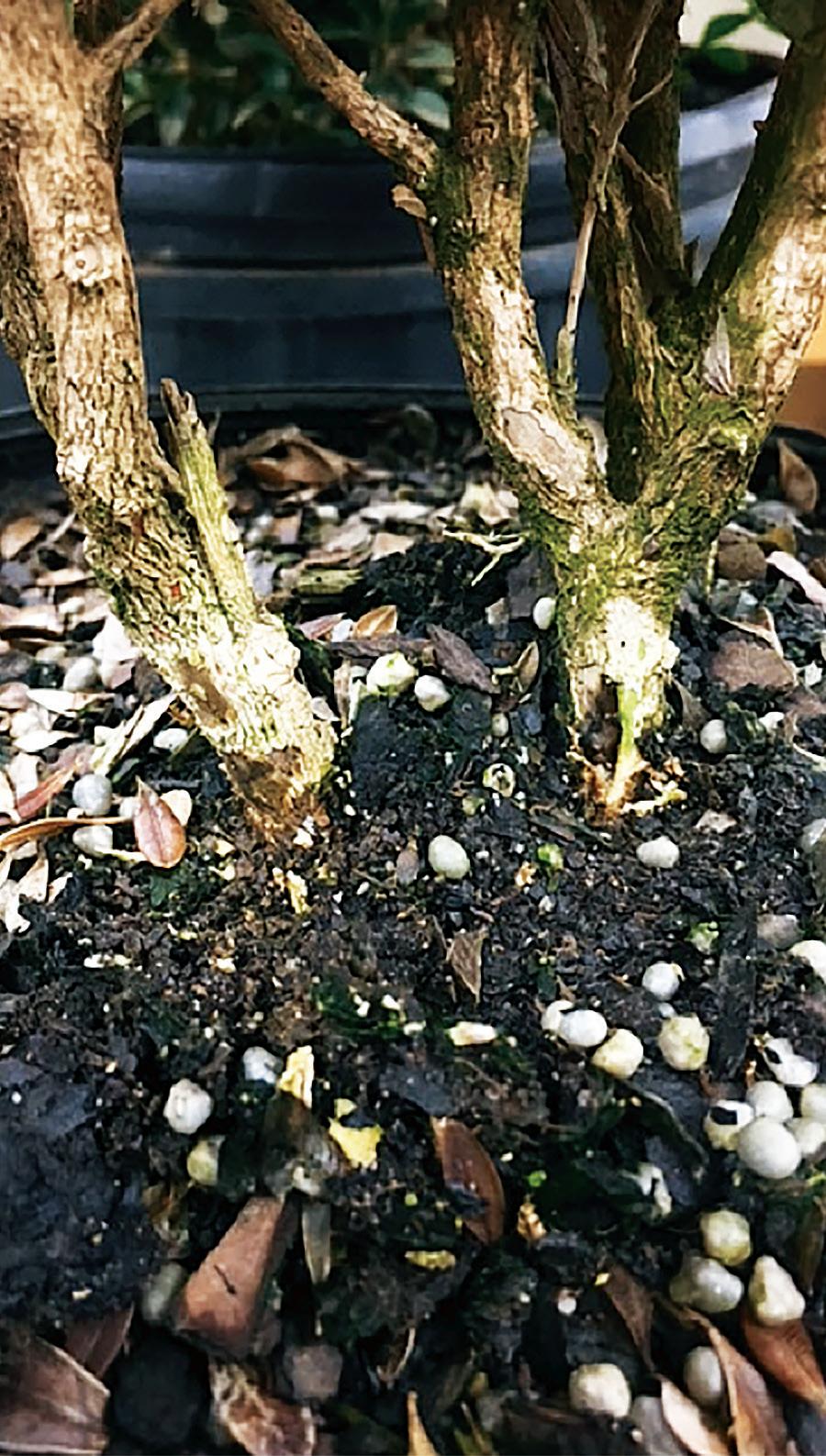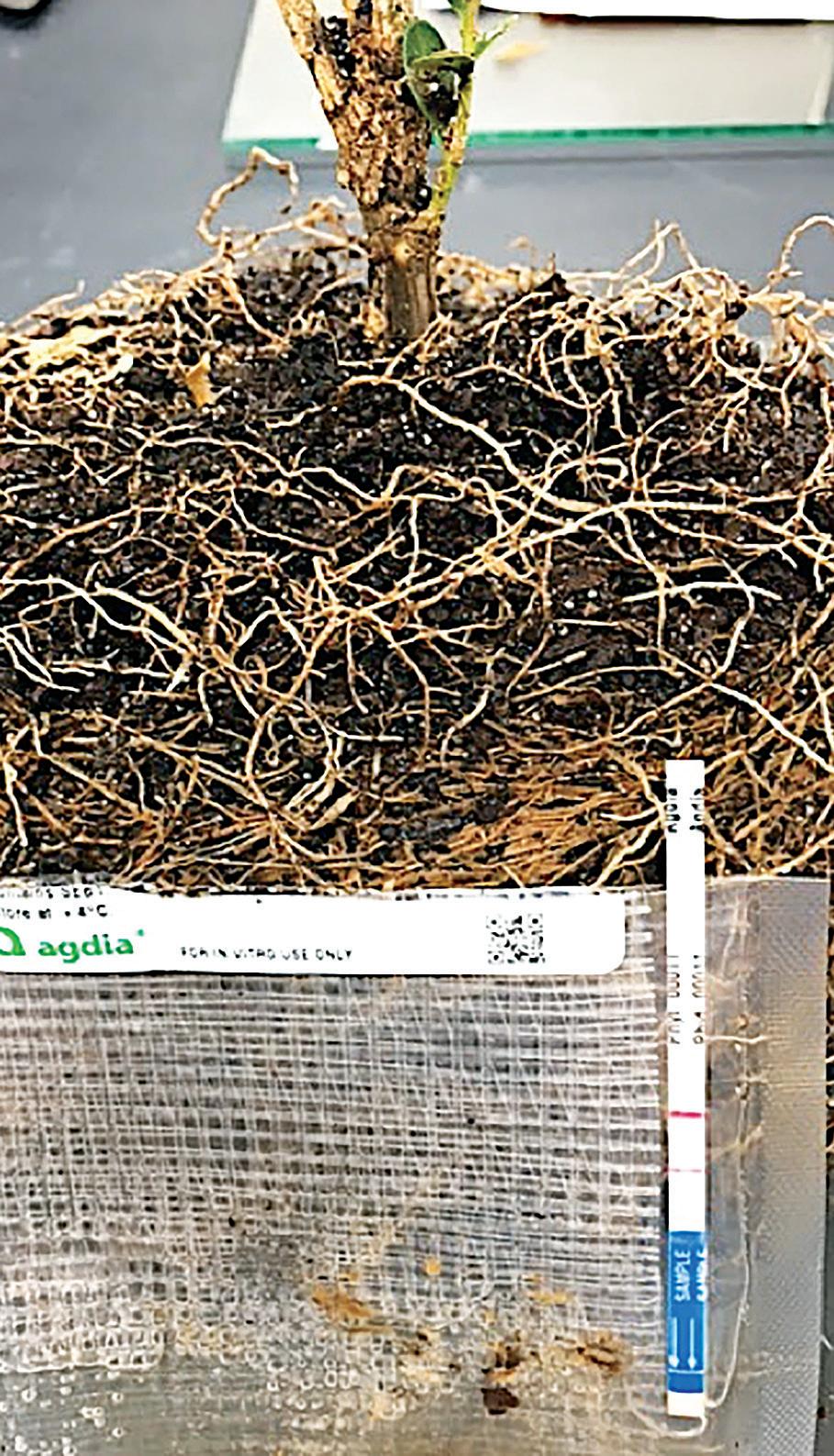
8 minute read
Phytophthora Root and Crown Rot of Boxwood
By Dr. Fulya Baysal-Gurel, Assistant Professor of Plant Pathology, Tennessee State University Otis L. Floyd Nursery Research Center Ornamental Pathology Program McMinnville, TN 37110 fbaysalg@tnstate.edu
Phytophthora root and crown rot of boxwood is caused by several species of Oomycetes (known as water molds). Some of the more frequently encountered Phytophthora species include P. nicotianae, P. cinnamomi, P. citrophthora and P. occultans. Many plant species, including American (common), Japanese, and English boxwood, are susceptible to this disease.
Advertisement
The pathogen can infect all growth stages of field and container grown boxwood plants. Warm, humid and rainy conditions favor disease development. Phytophthora spp. can survive in soil or potting substrate as resting spores (oospores, chlamydospores), and inside infected plant tissues as mycelium for long periods. Meantime, these resting spores are available to infect other healthy boxwoods or other host plants. When the environmental conditions are favorable, chlamydospores and oospores produce new mycelium or sporangia. Sporangia release zoospores into soil, and the zoospores swim toward healthy roots through saturated soil or irrigation water.
The general symptoms presented by infected plants include wilting, stunting, leaf shed, limb dieback, leaf chlorosis, off-color foliage, crown rot (gray to brown color) (Figures 1–4) and root rot (roots appear brown and water-soaked) (Figure 2). Depending on the disease progression in roots, foliar symptoms may be observed on a few branches or the entire plant (Figure 3).

Figure 1 A. Symptoms of boxwood Phytophthora crown rot.

Figure 1 B. Dark lesions beneath the bark may also be apparent outside infected stems
(Photo credit, Elizabeth Bush, Virginia Polytechnic Institute and State University, Bugwood.org)

Figure 2 A. Symptoms of boxwood Phytophthora root and crown rot; positive confirmed case using Phytophthora immunostrip test.

Figure 2 B. Symptoms of boxwood Phytophthora root and crown rot; positive confirmed case using Phytophthora immunostrip test.

Figure 3 A. Foliar symptoms of boxwood Phytophthora root and crown rot.

Figure 3 B. Foliar symptoms of boxwood Phytophthora root and crown rot.
What makes Phytophthora root and crown rot so difficult to control?
Phytophthora root and crown rot is stimulated by rising soil temperature and moisture, poor drainage, excessive irrigation, extended periods of heavy rainfall, flooding or when plants are planted too deeply (Figure 4). Fungicides need to be applied before the establishment of the pathogen. Therefore, preventative fungicide/biofungicide applications in a rotation are critical to control Phytophthora root and crown rot. Once it establishes, management of Phytophthora will require an integrated approach. Effective control strategies focus on scouting and early diagnosis along with sound cultural practices such as sanitation, good drainage, proper irrigation, irrigation water treatments, crop rotation, biofumigation and chemical/biological control. Good cultural practices include sanitizing tools, equipment, and reused pots (or avoid reusing pots altogether). If the production area or field had Phytophthora issues in the past, boxwood and other susceptible host plants should not be planted at least for three years.

Figure 4. A boxwood plant that was transplanted too deeply now exhibits Phytophthora root and crown rot symptoms.
Why is it important to rotate fungicides in programs that control plant diseases like Phytophthora root rot and crown rot?
Pathogen resistance to fungicides has been documented and the performance of many fungicides has been affected, to some degree, by plant pathogens that have developed resistance. Therefore, it is important to develop a fungicide rotation program that uses different modes of action, as indicated by their respective Fungicide Resistance Action Committee (FRAC) codes, as an important tool in limiting risk of fungicide resistance development.
In 2018, a trial was initiated by the Tennessee State University (TSU) Ornamental Pathology Program to evaluate fungicides alone, and in rotation, with treatments made on a 14-day schedule to control Phytophthora root rot. Boxwood ‘Green Velvet’ plants in 1 gal black plastic nursery containers were inoculated with P. nicotianae grown on rice grains. Inoculum consisted of four rice grains placed 5 cm below the potting substrate surface on the four opposite sides of the plant. Non-treated, non-inoculated and inoculated containers served as controls. Orkestra Intrinsic (10 fl oz/100 gal) (a.i. fluxapyroxad + pyraclostrobin) was applied as a spray to run-off using a backpack CO 2 -pressurized sprayer at 40 psi, while Empress Intrinsic (3 fl oz/100 gal) (a.i. pyraclostrobin), Orvego (14 fl oz/100 gal) (a.i. ametoctradin + dimethomorph), Segovis (3 fl oz/100 gal) (a.i. oxathiapiprolin), or Subdue Maxx (2 fl oz/100 gal) (a.i. mefenoxam) were applied as a drench (4.1 fl oz/plant). Total fresh weight was recorded, and severity of Phytophthora root rot was assessed using a scale of 0–100% of roots that showed an affect at the end of the trial. All fungicide treatments significantly reduced Phytophthora root rot severity compared to non-treated, inoculated control boxwood plants (Table 1). All fungicide rotation programs, as well as Empress Intrinsic alone, most effectively reduced Phytophthora root rot disease severity. Plants treated with Orvego alone had lower fresh weight compared to all other treatments, and were no different than the non-treated, inoculated control.
••••••
Table 1. Evaluation of fungicides alone and in rotation programs for the control of Phytophthora root rot of boxwood (Trial 1)
••••••
Treatment and rate (application dates) z: Non-treated, inoculated control 75.6 a 0.3 b
Phytophthora root rot severity (%) y: 0.0 d x
Total fresh weight (oz): 0.6 a
••••••
Treatment and rate (application dates) z: Non-treated, non-inoculated control
Phytophthora root rot severity (%) y: 75.6 a
Total fresh weight (oz): 0.3 b
••••••
Treatment and rate (application dates) z: Empress Intrinsic 23.8SC 3 fl oz/100 gal (1,2)
Application method: Drench
FRAC code: 11
Restricted-entry interval: 12 hr
Phytophthora root rot severity (%) y: 11.3 c
Total fresh weight (oz): 0.6 a
••••••
Treatment and rate (application dates) z: Orkestra Intrinsic SC 10 fl oz/100 gal (1,2)
Application method: Spray
FRAC code: 7 + 11
Restricted-entry interval: 12 hr
Phytophthora root rot severity (%) y: 23.1 b
Total fresh weight (oz): 0.6 a
••••••
Treatment and rate (application dates) z: Orvego SC 14 fl oz/100 gal (1,2)
Application method: Drench
FRAC code: 45 + 40
Restricted-entry interval: 12 hr
Phytophthora root rot severity (%) y: 21.9 b
Total fresh weight (oz): 0.4 b
••••••
Treatment and rate (application dates) z: Empress Intrinsic 23.8SC 3 fl oz/100 gal (1); alt Orvego SC 14 fl oz/100 gal (2)
Application method: Drench; Drench
FRAC code: 11; 45 + 40
Restricted-entry interval: 12 hr; 12 hr
Phytophthora root rot severity (%) y: 5.6 cd
Total fresh weight (oz): 0.6 a
••••••
Treatment and rate (application dates) z: Orvego SC 14 fl oz/100 gal (1); alt Orkestra Intrinsic SC 10 fl oz/100 gal (2)
Application method: Drench; Spray
FRAC code: 45 + 40; 7 + 11
Restricted-entry interval: 12 hr; 12 hr
Phytophthora root rot severity (%) y: 5.0 cd
Total fresh weight (oz): 0.7 a
••••••
Treatment and rate (application dates) z: Segovis 1.67SC 3 fl oz/100 gal (1); alt Subdue Maxx 22ME 2 fl oz/100 gal (2)
Application method: Drench; Drench
FRAC code: U15; 4
Restricted-entry interval: 12 hr; 12 hr
Phytophthora root rot severity (%) y: 5.6 cd
Total fresh weight (oz): 0.6 a
••••••
Treatment and rate (application dates) z: P – value
Phytophthora root rot severity (%) y: ≤ 0.0001
Total fresh weight (oz): ≤ 0.0001
••••••
z Application dates: 1 = 2 Nov.; 2 = 16 Nov. y Disease severity was based on percentage of roots affected. x Values are the means of eight replicates; treatments followed by the same letter within a column are not significantly different at P ≤ 0.05.
••••••
In another trial, the TSU Ornamental Pathology Program also evaluated fungicides alone and in rotation programs for controlling Phytophthora root rot on rooted cuttings of boxwood that had been inoculated with P. nicotianae grown on rice grains. Non-treated, non-inoculated and inoculated containers served as controls. Treatments were Subdue Maxx (2 fl oz/100 gal) (a.i. mefenoxam) only (drench) at a 10-wk interval and fungicide rotation program (Pageant Intrinsic 38WG (6 oz/100 gal) (a.i. boscalid + pyraclostrobin) (spray) alternated with Chipco 26019 (2 fl oz/100 gal) (a.i. iprodione) (spray) alternated with Empress Intrinsic (3 fl oz/100 gal) (a.i. pyraclostrobin) (drench). Total fresh weight and plant height were recorded, and severity of Phytophthora root rot was assessed using a scale of 0–100% roots affected. Phytophthora root rot disease pressure was high in this trial with non-treated, inoculated control rooted boxwood cuttings showing 53.0% disease severity. Both the fungicide rotation program (Pageant Intrinsic, Chipco 26019 and Empress Intrinsic) and Subdue Maxx alone significantly reduced Phytophthora root rot severity compared to the non-treated, inoculated control plants (Table 2). All fungicide-treated plants had increased plant height and total fresh weight compared to non-treated, inoculated control plants. Boxwood plants in the rotation program were taller than plants in both control groups.
Prompt action helps to manage Phytophthora root and crown rot
For boxwood and other susceptible host plants, scouting and proper identification of the disease and the disease-causing agent are critical for implementing of effective disease control strategies. If you would like to confirm that Phytophthora root and crown rot has infected your boxwood plants, you can submit a sample to your local university’s plant diagnostic laboratory.
••••••
Table 2. Evaluation of fungicides alone and in rotation programs for the control of Phytophthora root rot of boxwood rooted cuttings (Trial 2)
••••••
Treatment and rate (application dates) z: Non-treated, non-inoculated control
Phytophthora root rot severity (%) y: 0.0 b v
Plant height increase (%) x: 46.9 b
Total fresh weight (oz): 0.5 a
••••••
Treatment and rate (application dates) z: Non-treated, inoculated control
Phytophthora root rot severity (%) y: 53.0 a
Plant height increase (%) x: 21.8 c
Total fresh weight (oz): 0.3 b
••••••
Treatment and rate (application dates) z: Subdue Maxx 22ME 2 fl oz/100 gal (1,5)
Application method: Drench
Phytophthora root rot severity (%) y: 8.0 b
Plant height increase (%) x: 62.4 ab
Total fresh weight (oz): 0.6 a
••••••
Pageant Instrinsic 6 oz/100 gal (1,2); alt Chipco 26019 2 fl oz/ 100 gal (3); alt Empress Intrinsic 23.8SC 3 fl oz/100 gal (4)
Application method: Spray; Spray; Drench
FRAC code: 7 + 11; 2; 11
Restricted-entry interval: 12 hr; 12 hr; 12 hr
Phytophthora root rot severity (%) y: 1.2 b
Plant height increase (%) x: 70.3 a
Total fresh weight (oz): 0.6 a
••••••
Treatment and rate (application dates) z: P – value
Phytophthora root rot severity (%) y: ≤ 0.0001
Plant height increase (%) x: 0.0006
Total fresh weight (oz): 0.0042
••••••
z Application dates: 1 = 7 Nov.; 2 = 21 Nov., 3 = 12 Dec., 4 = 2 Jan., 5 = 9 Jan. y Disease severity was based on percentage of roots affected. x Percent plant height increase was calculated according to the formula: [(final plant height — initial plant height)/initial plant height x100]. v Values are the means of five replicates; treatments followed by the same letter within a column are not significantly different at P ≤ 0.05




